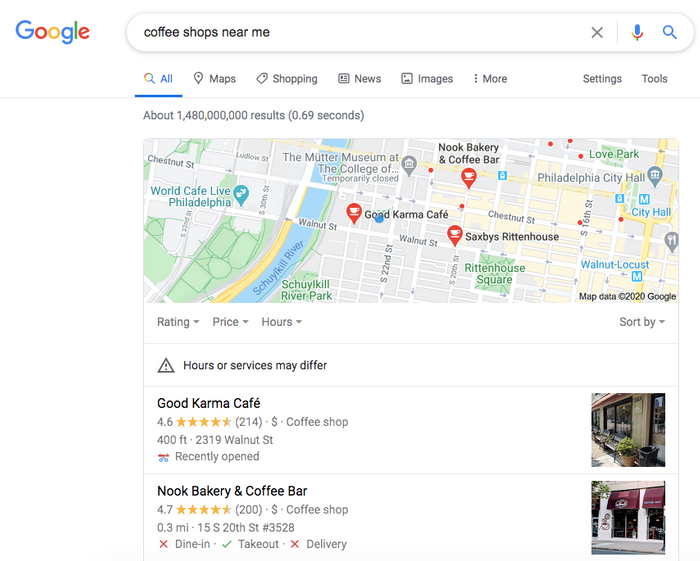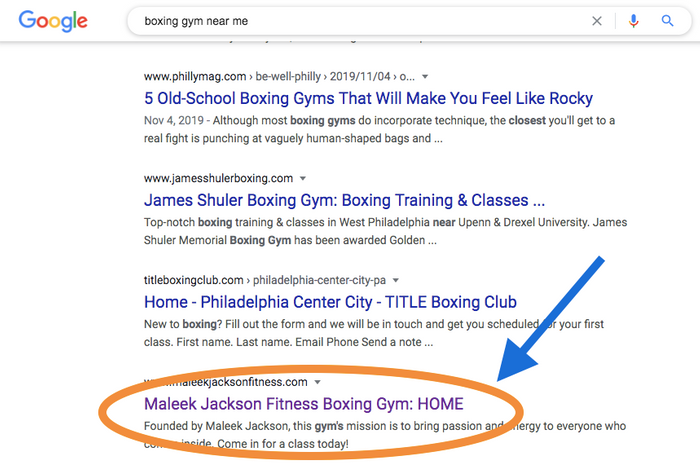Ever Heard of Organic for Free?

Organically?
When you search Google, how often do you go past that first page of search results? More often than not, many people will find what they’re looking for within the first 4 or 5 search results, but what about the abundance of results that we chose to dismiss? Does that mean those results did not have the content/services we were looking for? Maybe, but more often than not many businesses just do not have the proper exposure or presence online to show up in those top rankings. Don’t let your business fail to receive the engagement it deserves online. Let’s talk about how you can set your business up to eventually get on that first page of results, “organically,” in other words the process of efficient Search Engine Optimization (SEO). In this blog, we’ll focus on SEO in relation to exclusively Google’s search engine.
The organic search result is the product of good SEO. The more efficient your sites SEO is, the more opportunity you have for your organic search results to increase. Efficient SEO is the foundation of your brand’s online presence. The beauty of it is it’s free, so this is probably the only time you will ever hear organic being cheap. SEO has numerous factors, from the way your website was built to the links and connections you make, for it to be interpreted and exposed properly by the search engine.
Reach and Engagement
Before we dive into the details let me explain why organic search results are substantial to your business from an analytical perspective. As a Data Analyst, I think about numbers just like business owners do, you always want the maximum output with minimal input in almost any scenario. Vitris’s Data Analytics Team examines frequencies and determines what metrics to capitalize on in order to maximize conversion rates for our clients.
When measuring Analytics for websites, some very basic but substantial metrics used to track performance, for example, are the number of current/new users, number of sessions, avg. session duration, click-through-rate (CTR) and bounce rate. Certain metrics such as avg. session duration, CTR, and bounce rate are more reliant on your website’s UX/UI design efficiency, whereas metrics such as the number of sessions, current users, and new users, may depend on your website’s presence online, otherwise known as your websites SEO.
The main goal of SEO is to efficiently optimize websites such that they are in the position to rank among the highest on Search Engine Results Pages (SERP) organically. This allows the opportunity for metrics such as the number of sessions, current users, and new users to increase. From a business standpoint, you (the business owner) want the most organic activity you can get because it is FREE.
The SERP
When a user uses keywords to search Google, it provides you with a search results page based on your search query. Note not everyone’s SERP will look the same... Search results come in three forms-personalized, paid, and organic. Google offers automated personalized search results based on factors such as the user's search history, and location (as much as we use Google to learn about different topics, Google does the same with each individual user, meaning it learns about you too). Google can identify the user’s interests and demographics to give the most insightful results on the SERP based on the users’ past search history.
Google's Advertising Platform “Google Ads” gives merchants the ability to advertise their products/services, a medium known as paid search. This medium can be important to capitalize on in your web applications search engine ranking, BUT for small business owners, it is vital that they first do all they can to optimize their organic search results, because again it is free, more for less.
An Inside Look Into SEO
At Vitris, we take the necessary steps in optimizing and curating the websites we establish for our clients so that they can succeed and flourish. Here’s a look into some of the best practices we suggest and implement for our clients.
Local Search/Google My Business
Google pulls geolocation of your device on phone searches, so it can offer content that is geographically relevant. We focus on helping our clients rank higher up on local searches organically. Searches that have any kind of local intent, “near me”, or including the name of the city they’re in, “in Philadelphia”.
Vitris has built out an API integration with Google My Business (GMB). GMB is a tool for small local businesses to gain more exposure on online local searches, Google maps, and also gives businesses a knowledge panel as seen to the right to help give users more information about your business right off the SERP.

This is one of our client’s Maleek Jackson’s Fitness Boxing Gym, as you can see the knowledge panel Google offers for GMB accounts has a substantial amount of aggregated information. It is important to provide users with information that allows them to learn more about what you do, where you are, and when they can visit you. It is important to keep the information accurate and up to date, as new content and information helps aid good SEO practice. At Vitris, we help onboard our clients with their GMB account and hold strategy meetings with them to figure out exactly what they want to accomplish and then work to move as autonomously as possible with their input.
That being said, from a business owner’s point of view, we strongly suggest attentiveness in responding to reviews. Good reviews go a long way in ranking your business higher in prominence in your local area. Google will value that people are satisfied with your service and showcase you in more local search results.

The Fundamentals
We’re about to get a little technical, so bear with me
Crawling/Indexing → Site Maps → Structured Data
It is essential to give Google different ways to best understand your website, the better it assesses and interprets your site, the better it sets you up for success. Google has bots (web crawlers) that follow certain paths through the pages on your site; it then indexes the information assigning keyword references for each page. This process of crawling and indexing is Google’s way of interpreting and understanding your web page.
Some ways to assist Google with a smooth assessment of your website is with the incorporation of sitemaps, which display a hierarchy of the pages on the site, and provides a clear layout of the links associated so it is easier for Google crawlers to follow a flow through everything. Another way to help Google’s crawling process is through the use of Structured Data. Structured data is an open-source format agreed upon among all social media networks and search engines, the tech industry will slowly transition to using structured data over the next couple of years, vs. meta tags. Structured Data markup each page with breadcrumbs, a navigational aid for the crawlers to maneuver through all the elements and pages of the website, in order to have the utmost understanding of and to interpret the site into relevant indexes.
Crawl Status Errors
Errors come hand-in-hand with technology if different elements are not built and implemented properly. Search Engine crawlers must first be able to find your website online, understand what your site is offering, and conclusively organize the information in a way that will best showcase your website. This process without proper web design fundamentals can cause crawl status errors. Google helps developers alert and monitor these errors when they occur through Google Search Console (GSC) reports. GSC tracks the ability of Google’s bots to crawl around a website and shows what the bot sees and indexes when it crawls the site, giving you a report on what the errors are and what needs to be updated. This is vital to building the foundation of efficient SEO going forward.
Of our 60 + websites here at Vitris, we have zero crawl errors or crawl failures. This is in part due to the simplicity of our websites, as we only do one level of linking in our linking architecture, thus making it as simple as possible for crawlers to maneuver.

Accessibility/Efficiency
Accessibility and efficiency of the web application are vital components of the groundwork of your site and good SEO. At Vitris we use a framework known as Angular that makes our applications compatible across all devices, while also offering the maximum speed possible. Angular was developed by Google, which gives developers an advantage to proper SEO with Google. We use server-side rendering through Angular to guarantee the fastest speed a web platform can offer, increasing efficiency across all devices.
Accessibility in terms of the usability of disabled individuals accessing your web application can also impact your SEO ranking. At Vitris we use mark up tools such as text, call to action, and image description to help with this. Yes, people with disabilities use the web too just like all of us. Creating a web design that suits disabilities such as being blind, color blind or deaf will automatically boost your site up in rankings because google understands your site has flexible usability.
Speed is an important element of your web applications efficiency, we already mentioned the use of Angular’s framework in regards to speed and accessibility, but the biggest hindrance to speed are images. To help with this, you can compress your images, at Vitris we take a step further and store them in next-gen image format (WebP). We also cache static files (such as images) into a Content Delivery Network (CDN), which basically means the files are stored in multiple servers across the world, this helps accelerate load time. Again just like many technical practices, there are many simple ways to make errors if the implementation is not proper, we at Vitris suggest using Google’s Lighthouse Test to help with this. Lighthouse is an auditing tool to improve the quality of the web pages, the test will show you errors, give your site a score, and provide feedback to improve it. Our Vitris team uses this test throughout our website creation process, to see if anything needs to be fixed before adding more features. In addition, as soon as we realize and audit when lighthouse is failing us for a specific cause, we then make the change and deploy it across all of our websites.
Keeping Up With Technology Through Vitris
SEO comes down to everything working together effectively, to achieve optimal organic search results it does get technical, and that is why our team here at Vitris is here to help. SEO starts from the ground up and we understand business owners want to capitalize on the organic search. That is why our website application products are delivered to our clients with the proper SEO fundamental practices in place so they can reap the most benefit. At Vitris we not only provide websites curated with cutting technological practices, but we also offer the support delivering updates to help maintain these websites and assure everything goes smoothly going forward.
You run the business, we’ll take care of the rest.
Cheers!
Dhak
Data Analytics and Reporting Intern